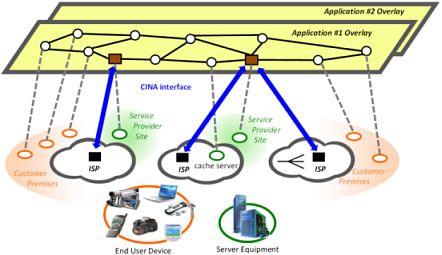CINA Interface
Collaboration Interface between Networks and Applications
Today's Internet distributed applications such as video-on-demand, TV, cloud computing and social networks operate in one of two ways: Over-the-top (OTT) where the application provider uses the Internet as a "dumb pipe" without any control or special payment or through a closed and integrated package provided by an ISP. These two approaches have structural problems. In OTT the application has no control over the quality of the data delivery. In the integrated case the ISP has to brand its products and will have a limited number of clients.
CINA, the Collaboration Interface between Network and Applications creates a new opportunity for over-the-top application providers to request special services from network providers. This can generate new revenue streams for network providers from content distribution and allow for joint collaboration in the optimisation of the network and application logic.
The figure below illustrates how CINA works between different networks and the overlay layer. The interface enables the exchange of information and the invocation of network services offered by ISPs.

Numerous candidate network services could be offered via the interface. Some examples of those under development include the following.
- Multicasting. Since applications may be spread over several ISPs, native intra-domain multicast mechanisms can be enhanced with techniques such as hybrid application-network layer multicast or operator-instantiated high capacity nodes in the network.
- Caching. Employing specialized nodes provided by the ISP or third parties can save bandwidth in the network. Caching can also aid in the provisioning of catch-up services.
- Bandwidth on demand. Edge devices may be connected to multiple access networks. Methods for provisioning capacity-on-demand over aggregated access networks are being investigated.
- Dynamic QoS mapping. Application QoS requirements may be invoked and mapped dynamically to network capabilities, end user devices, and access networks.
- Content adaptation. Heterogeneous end user devices and access network capabilities will require dynamic and distributed multimedia con- tent adaptation techniques.
In practice the interface consists of extensible JSON definitions which are then implemented using off-the-shelf HTTP. Below one can see an example for multicast:
POST /multicast HTTP/1.1
Host: custom.cina.example.com
Content-Length: [TODO]
Content-Type: application/json;
profile=http://www.envision-project.org/cina/multicaster-schema#AllocateRequest
Accept: application/json;
profile=http://www.envision-project.org/cina/multicaster-schema#AllocateResponse {
"multicast-address-family" : "ipv4",
"start-time" : {
"min" : "2011-12-19T16:31:57",
"max" : "2011-12-19T18:39:57"
},
"lease-time" : {
"min" : "2011-12-19T16:59:57",
"max" : "2011-12-19T18:29:57"
},
"current-time" : "2011-12-19T16:29:57",
"srcs" : [
{
"src-address" : "123.123.123.12",
"src-port" : 1111,
"destination-port" : 1111,
"max-bitrate" : 512
},
{
"src-address" : "123.123.123.13",
"src-port" : 1111,
"destination-port" : 1111,
"max-bitrate" : 256
}
],
"forecasted-user-number" : 555
}
The CINA interface is being defined by a consortium of leading academic and industrial partners in the ENVISION project and will be open and standardised for anyone to use. It includes security functions to allow for authentication and authorisation and it's of very easy implementation and deployment.
By allowing the network provider a place in the value chain of content distribution, CINA will provide new revenue streams for ISPs (crucial for the investment needed to upgrade Internet access), it will allow applications to deliver more cost-effective quality-of-experience and will allow for joint co-optimization of the network and applications systems. Finally, since it can be deployed incrementally it addresses the frequent "chicken and egg" problem of deploying innovative network services.
Further reading:
D3.1, Initial Specification of the ENVISION Interface, Network Monitoring and Network Optimisation Functions, February 2011 (updated May 2011).
envision_d3.1-v2.pdf.
B. Mathieu, S. Ellouze, N. Schwan, D. Griffin, E. Mykoniati, T. Ahmed and O. Ribera Prats, Improving end-to-end QoE via close cooperation between applications and ISPs, IEEE Communications Magazine, special issue on Future Media Internet, March 2011.
N. Schwan, K. Satzke, D. Griffin, B. Mathieu and T. Ahmed, Fostering Cooperation between Overlay Applications and Underlying Networks, Bell Labs Technical Journal, special issue on Application Enablement, Vol. 16, No. 2, September 2011.
D3.2, Refined Specification of the ENVISION Interface, Network Monitoring and Network Optimisation Functions, January 2012, envision_d3.2_final_public.pdf.

